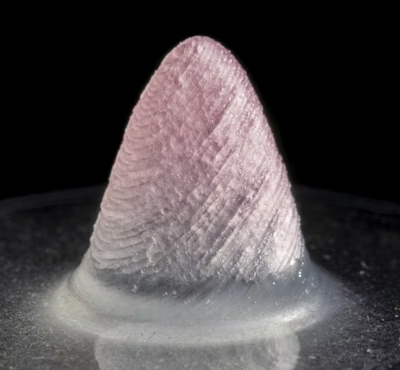This illustration exhibits a 3D printed coronary heart ventricle engineered with fiber-infused ink. Credit score: Harvard SEAS
By Kat J. McAlpine / SEAS Communications
During the last decade, advances in 3D printing have unlocked new prospects for bioengineers to construct coronary heart tissues and constructions. Their targets embrace creating higher in vitro platforms for locating new therapeutics for coronary heart illness, the main reason for demise in the USA, accountable for about one in each 5 deaths nationally, and utilizing 3D-printed cardiac tissues to guage which therapies may work greatest in particular person sufferers. A extra distant purpose is to manufacture implantable tissues that may heal or exchange defective or diseased constructions inside a affected person’s coronary heart.
In a paper revealed in Nature Supplies, researchers from Harvard John A. Paulson Faculty of Engineering and Utilized Sciences (SEAS) and the Wyss Institute for Biologically Impressed Engineering at Harvard College report the event of a brand new hydrogel ink infused with gelatin fibers that permits 3D printing of a purposeful coronary heart ventricle that mimics beating like a human coronary heart. They found the fiber-infused gel (FIG) ink permits coronary heart muscle cells printed within the form of a ventricle to align and beat in coordination like a human coronary heart chamber.
“Folks have been attempting to copy organ constructions and capabilities to check drug security and efficacy as a approach of predicting what may occur within the scientific setting,” says Suji Choi, analysis affiliate at SEAS and first creator on the paper. However till now, 3D printing strategies alone haven’t been in a position to obtain physiologically-relevant alignment of cardiomyocytes, the cells accountable for transmitting electrical alerts in a coordinated trend to contract coronary heart muscle.
“We began this challenge to handle among the inadequacies in 3D printing of organic tissues.”
– Kevin “Equipment” Parker
The innovation lies within the addition of fibers inside a printable ink. “FIG ink is able to flowing by the printing nozzle however, as soon as the construction is printed, it maintains its 3D form,” says Choi. “Due to these properties, I discovered it’s doable to print a ventricle-like construction and different complicated 3D shapes with out utilizing further assist supplies or scaffolds.”
This video exhibits the spontaneous beating of a 3D-printed coronary heart muscle. Credit score: Harvard SEAS.
To create the FIG ink, Choi leveraged a rotary jet spinning method developed within the lab of Kevin “Equipment” Parker, Ph.D. that fabricates microfiber supplies utilizing an method just like the way in which cotton sweet is spun. Postdoctoral researcher and Wyss Lumineer Luke MacQueen, a co-author on the paper, proposed the concept fibers created by the rotary jet spinning method might be added to an ink and 3D printed. Parker is a Wyss Affiliate School member and the Tarr Household Professor of Bioengineering and Utilized Physics at SEAS.
“When Luke developed this idea, the imaginative and prescient was to broaden the vary of spatial scales that might be printed with 3D printers by dropping the underside out of the decrease limits, taking it right down to the nanometer scale,” Parker says. “The benefit of manufacturing the fibers with rotary jet spinning fairly than electrospinning” – a extra typical methodology for producing ultrathin fibers – “is that we will use proteins that will in any other case be degraded by {the electrical} fields in electrospinning.”
Utilizing the rotary jet to spin gelatin fibers, Choi produced a sheet of fabric with an identical look to cotton. Subsequent, she used sonification – sound waves – to interrupt that sheet into fibers about 80 to 100 micrometers lengthy and about 5 to 10 micrometers in diameter. Then, she dispersed these fibers right into a hydrogel ink.
“This idea is broadly relevant – we will use our fiber-spinning method to reliably produce fibers within the lengths and shapes we would like.”
– Suji Choi
Essentially the most tough facet was troubleshooting the specified ratio between fibers and hydrogel within the ink to keep up fiber alignment and the general integrity of the 3D-printed construction.
As Choi printed 2D and 3D constructions utilizing FIG ink, the cardiomyocytes lined up in tandem with the course of the fibers contained in the ink. By controlling the printing course, Choi may subsequently management how the center muscle cells would align.

The tissue-engineered 3D ventricle mannequin. Credit score: Harvard SEAS
When she utilized electrical stimulation to 3D-printed constructions made with FIG ink, she discovered it triggered a coordinated wave of contractions in alignment with the course of these fibers. In a ventricle-shaped construction, “it was very thrilling to see the chamber really pumping in an identical technique to how actual coronary heart ventricles pump,” Choi says.
As she experimented with extra printing instructions and ink formulation, she discovered she may generate even stronger contractions inside ventricle-like shapes.
“In comparison with the actual coronary heart, our ventricle mannequin is simplified and miniaturized,” she says. The group is now working towards constructing extra life-like coronary heart tissues with thicker muscle partitions that may pump fluid extra strongly. Regardless of not being as robust as actual coronary heart tissue, the 3D-printed ventricle may pump 5-20 instances extra fluid quantity than earlier 3D-printed coronary heart chambers.
The group says the method may also be used to construct coronary heart valves, dual-chambered miniature hearts, and extra.
“FIGs are however one software now we have developed for additive manufacturing,” Parker says. “Now we have different strategies in growth as we proceed our quest to construct human tissues for regenerative therapeutics. The objective is to not be software pushed – we’re software agnostic in our seek for a greater technique to construct biology.”
Extra authors embrace Keel Yong Lee, Sean L. Kim, Huibin Chang, John F. Zimmerman, Qianru Jin, Michael M. Peters, Herdeline Ann M. Ardoña, Xujie Liu, Ann-Caroline Heiler, Rudy Gabardi, Collin Richardson, William T. Pu, and Andreas Bausch.
This work was sponsored by SEAS; the Nationwide Science Basis by the Harvard College Supplies Analysis Science and Engineering Heart (DMR-1420570, DMR-2011754); the Nationwide Institutes of Well being and Nationwide Heart for Advancing Translational Sciences (UH3HL141798, 225 UG3TR003279); the Harvard College Heart for Nanoscale Programs (CNS), a member of the Nationwide Nanotechnology Coordinated Infrastructure Community (NNCI) which is supported by the Nationwide Science Basis (ECCS-2025158, S10OD023519); and the American Chemical Society’s Irving S. Sigal Postdoctoral Fellowships.
Wyss Institute
makes use of Nature’s design rules to develop bioinspired supplies and units that may remodel drugs and create a extra sustainable world.

Wyss Institute
makes use of Nature’s design rules to develop bioinspired supplies and units that may remodel drugs and create a extra sustainable world.





